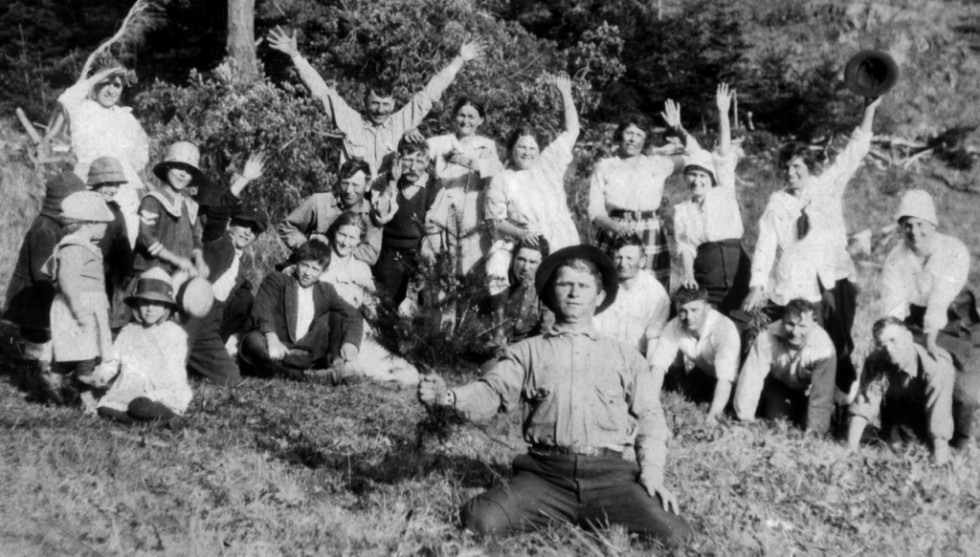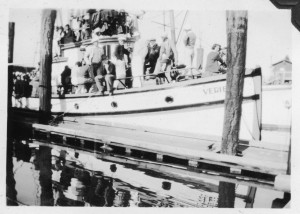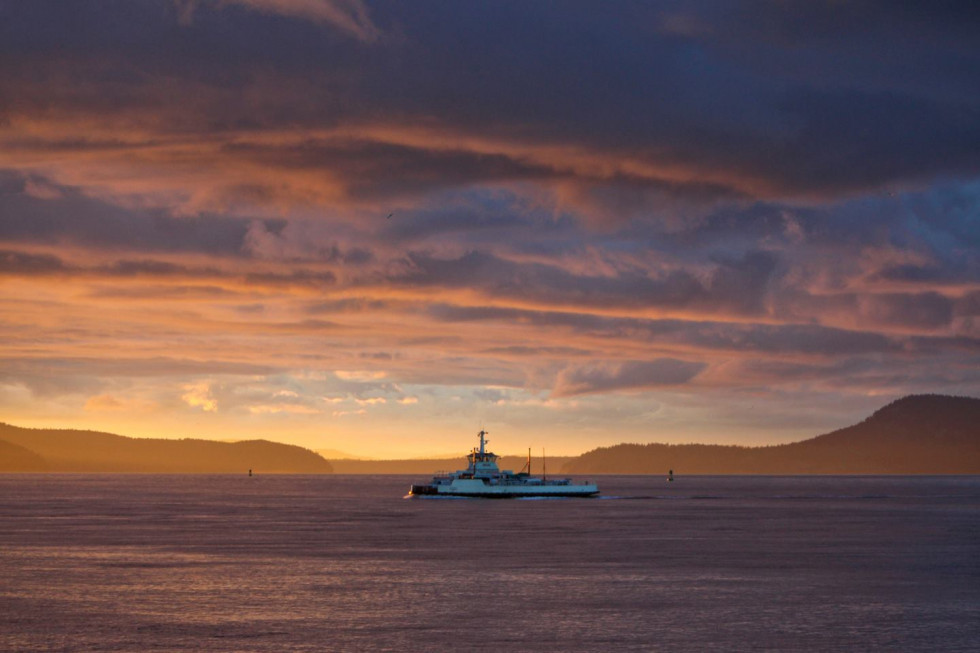Croatian seafarers were instrumental in developing the twentieth century salmon industry on Puget Sound. This article is excerpted with permission from Croatian Fishing Families of Anacortes, written by Bret Lunsford, Anacortes Museum Education. The account traces the often harrowing stories of immigration to America, and how these histories varied from person to person, and from decade to decade. Settling in Anacortes, the voices tell of resourceful traditions and cultural challenges as the newcomers made a home of this place halfway ‘round the world.

TWILIGHT
Seiner Twilight, owned by Peter and Ernest Babarovich and Frank Bozanich, ca. 1915
Courtesy Phyllis Ennes
The story of the Croatian settlers in Anacortes starts in the 1870s when town founder Amos Bowman began promoting “Anacortes” – named in honor of his wife, Anne Curtis – as the new center of the world. At the same time that Bowman was firing up the presses of the Northwest Enterprise, John Barbarovich was setting out from the island of Brac in the Adriatic Sea , which he left as a 23 year old in 1879. John journeyed to San Francisco and then Seattle; by 1889 he was a pioneer homesteader on Sinclair Island when nearby Anacortes was a small village on the verge of a railroad-driven real estate speculation boom in the year 1890.
It was during the last decades of the Nineteenth Century and the first decade of the Twentieth Century that Anacortes’ early Croatian immigrants sailed and steamed across the Atlantic to America, working initially in the mines, factories and railroads of the new world. While Anacortes was inventing itself as cannery & lumber hub in need of a work force, John Barbarovich reestablished contact and sent travel money for his brothers in Splitska, Brac. While John Babarovich is recognized as the first Croatian in the area, he was not the first in Anacortes, nor was his brother, Peter. “Austrians” were undoubtedly among the transient laborers working in Anacortes during the 1890s, but a 1914 article in the Anacortes American reported “Mr. John Padovan is said to have been the first Austrian to locate in Anacortes.”
As more Croatian families settled in town, they tended to want to live near one another, and the work at the fishing docks and timber mills. Two primary Croatian neighborhoods formed in Anacortes: One in Old Town near the original St. Mary’s Catholic Church and including 6th, 7th and 8th Streets; the other concentration was West of the Cap Sante Waterway and Morrison Mill, including 14th through 17th Streets between Commercial and K Avenue. Within these neighborhoods they would make their wine, raise and cook food their own way, and sing and dance to their songs from home, regardless of the norms or Prohibition laws of their adopted country. Most of the early Croatian fishing families in Anacortes families originated from just a few home islands: the villages of Vela Luka and Blato on the island of Korcula, the town of Splitska on the island of Brac, and also from the island of Vis. Certainly there were other Slavs from throughout the Balkans who spent time in town, but those who stuck in Anacortes shared a few dozen names and centuries of interconnected history. St. Mary’s Church became a center for the Croatian and non-Slav Catholic community, and a site of cultural connection and cross-cultural awareness. As the fishermen worked to advance themselves and the entire fishing industry, not everyone was enthusiastic about the “Austrian” influx. One “fanatic” went as far as to throw an incendiary device into the church in 1924; that decade also saw the rise of “nativist” activity in town, including marches and rallies of the Ku Klux Klan. To the “Americans” these “Austrians” were considered to be foreigners. Ironically, these Croatians referred to non-Croatians as “foresti” or foreigners, and later in life laughed about the humor of the role reversal.

CAP SANTE
Croatian immigrants (Mike “Chupa” Barcott in foreground) at picnic on Cap Sante, Anacortes, 1910s
Courtesy Frances Svornich
Between the 1890s and the Great Depression, the modern Puget Sound purse-seine fleet was created and expanded. With that expansion a recurrent pattern formed: A Dalmatian would hear of Anacortes and come to work in sawmills, canneries or fishing. Word, and sometimes ticket-money, was sent to relatives and friends: “Come to Anacortes, there is good work here.” John Suryan had journeyed to Anacortes on word of employment from a relative already here. He made money and sent tickets for his kids, Katy and Dick Suryan, and their spouses. Rudolf Franulovich (Katy’s husband) and Dick Suryan were born to fishing in their hometown of Vela Luka. Their success as innovators in the Puget Sound salmon fishery did much to populate Anacortes with Franuloviches and Suryans and other “Lucani” from the island of Korcula . These Dalmatians possessed seafaring experience, net-mending and fishing skills, plus the group cohesiveness that combined to form the basis for the purse seine fishing fleet that was to come.

May 1934- VeribusJohn Tasovac’s purse seiner Veribus is loaded with friends and family for a beach picnic in the San Juan Islands in 1934.
Courtesy Gary Keister
Through the years between the turn of the century and The Great War, the Croatian community in Anacortes grew with the salmon industry, and even began to spur the growth of the industry – both its mechanical and organizational technology. While many Puget Sound ship builders were involved in how the modern purse seine boat evolved –the Anacortes American headline for September 16, 1915 credits John Babarovich with a primary role: “Pioneer of Purse-Seining Industry Called To Death; Prominent Figure In Salmon Industry Of North Pacific Was First To Adopt Use Of Power In Boats.”: When Mr. Babarovich came to Anacortes the purse-seining industry was in a primitive stage, the work being done by oar-propelled boats. He constructed and operated the first power purse-seine boat here and the experiment resulted in the construction of hundreds of similar boats all over Puget Sound . Realizing that Anacortes was destined to be the center of the Puget Sound salmon industry, he built many purse-seine boats, both for himself and other fishermen, and he was a familiar and picturesque figure in the salmon industry from Alaska to the Columbia River . His purse-seine boats were known as the finest and best equipped in the fleet.” Local fishermen continued the progress in mechanical innovations on their boats to marketing and processing advancements. Dick Suryan operated a floating cannery in Alaska and opened a fish plant on Guemes Channel, while Frank Barcott joined the originally Everett-based Fishermen’s Packing Corporation – a cooperative venture of salmon skippers formed in 1928 to help guarantee markets for their catch.
Nearness to the fishing grounds was a chief advantage in the growth of Anacortes’ fishing industry. This proximity to the resource brought canneries to a dozen sites on the fast-flowing Guemes Channel. Naturally, many fishermen chose Anacortes as their home. Yet Anacortes became the salmon-season haven of the fishing fleet due to active recruitment and infrastructure improvements. Some local residents may have been unnerved when the weekend population swelled by one thousand fishermen, but most joined the fun of the Fishermen’s Dances, and respected how the fleet contributed to the local economy. Grocers Paul and Mary (Babarovich) Luvera spoke the language of these Croatian fishermen in more ways than one; they worked to build their own business and the general economic health of Anacortes, acting as advocates for Cap Sante Waterway expansion, pro-fishermen legislation at the Chamber of Commerce and on the broader political stage. With the fortuitous expansion of its Cap Sante Waterway in early 1930s, Anacortes reaped the enlargement of its own and visiting fishing fleets. Anacortes’ support of fishermen played a crucial role in the negotiations to relocate the Fishermen’s Packing Corporation cannery from Everett to Anacortes. The “Fish Pack” members, who were predominantly Croatian, voted for relocation in 1937, after which Anacortes could truly claim to be the world’s capitol of salmon canning.
(Excerpted from CROATIAN FISHING FAMILIES OF ANACORTES by Bret Lunsford)
CROATIAN FISHING FAMILIES OF ANACORTES
© 2011 by Bret Lunsford All rights reserved
Published by the American Croatian Club of Anacortes
1202 7th Street, Anacortes , Washington , USA 98221
